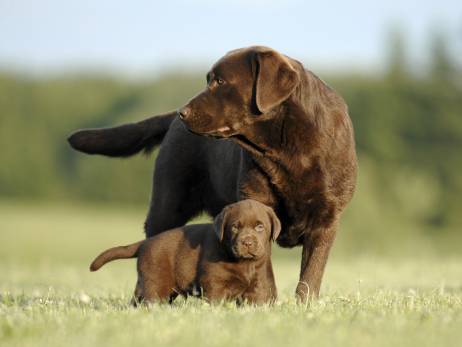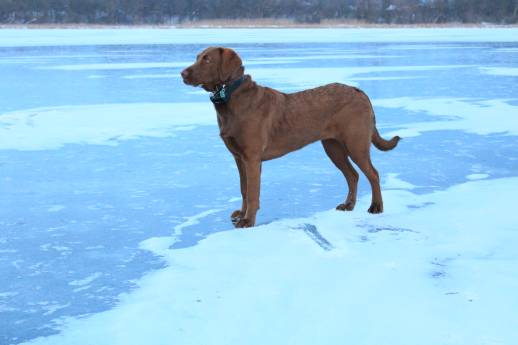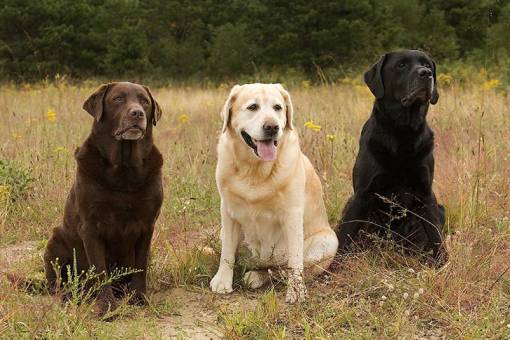Connect with a verified veterinarian in minutes. Licensed vets are available 24/7 to answer your questions. No need to worry about your furry family member.
Labrador Retrievers are one of the most popular dogs in the US! And you probably know why! The dogs are known for their happy natures, stable temperament, and for their love of kids. Each of these qualities makes the Lab a great family companion.
There’s no question that Labs can get rather large; however, how pet parents of a new puppy may wonder what to expect. What’s a normal weight for my dog at a certain age? It’s fun watching a Lab puppy grow up; you definitely want to make sure the puppy’s weight is on target.
Are you the pet parent of a new Labrador Retriever puppy? Are you wondering what to expect when it comes to your puppy’s size as he grows? If so, you’ve come to the right place. We’ve put together a chart that follows your puppy month by month, showing the weights for males and females. You’ll also find helpful information on what to expect with your puppy as he grows through his first year!
First, we’ll walk you through an overview of the breed and then get on to the growth chart. Let’s get started!
What is a Labrador Retriever?
Labrador Retrievers come from Newfoundland, an island off the Canadian coast (on the Atlantic side). The dogs were originally called St. John’s dogs, after the capital of Newfoundland. The dogs were bred to help fishermen in the 1700s but also became beloved family companions.
The dogs worked alongside their pet parents every day, retrieving fish. The fish escaped off the hooks or from the net, so the dog would go in after them. At the end of a long day, the fisherman and his dog would head home and spend time with the family. What a sweet beginning!
Labs are famous for not only being the number one dog in the US. They’re also the most recognized, even by those who don’t have dogs. These are highly athletic dogs, and they’re friendly to everyone. These beautiful dogs are highly intelligent and have a ton of energy!
Most Labrador Retrievers today are family companions who love nothing better than to be with their humans. Even so, these dogs are still amazing work dogs.
Because Labs are so sweet, they make great therapy dogs. They’re sometimes used to visit hospitals or senior residences. They’re also amazing assistance dogs and help those who have disabilities. Labs also work as search and rescue dogs, retrieve for hunters, and more.
While Labs can do a wide variety of work, they don’t make good watchdogs. That’s because they’re sweet and love almost everyone they meet!
OK, now, let’s get on to that growth chart!
Labrador Retriever Growth Charts – Female & Male
Just like us, puppies go through growth milestones, growth spurts, and more. It’s essential to ensure a puppy is healthy by comparing his weight with the average for other Labs. We’ve created two charts to help you out: a growth chart for Female Labs & one for Male Labs.

Review symptoms, medications & behavior to keep your pets healthy with a Vet Online in just minutes.
Ask a Vet Live NowFemale Lab Growth Chart
| Female Lab’s Age | Female Average Weight |
| 3 mos | 20-26 lbs (9-12 kg) |
| 5 mos | 35-49 lbs (16-19 kg) |
| 7 mos | 40-55 lbs (20-25 kg) |
| 9 mos | 48-62 lbs (222-28 kg) |
| 11 mos | 53-66 lbs (24-30 kg) |
| 13 mos | 55-68 lbs (25-31 kg) |
| 15 mos | 55-70 lb (25-32 kg) |
Male Growth Chart
| Male Lab’s Age | Average Weight |
| 3 mos | 22-26 lb (10-12 kg) |
| 5 mos | 33-49 lb (15-19 kg) |
| 7 mos | 51-59 lb (23-27 kg) |
| 9 mos | 57-68 lb (26-31 kg) |
| 11 mos | 62-75 lb (29-35 kg) |
| 15 mos | 64-77 lb (29-35 kg) |
What to Expect?
In this section, we’ve included information on what to expect at your Lab puppy’s major milestones through the first year! Let’s get started!
Birth to Two Weeks
This a time when puppies sleep quite a bit. When they’re awake, puppies are busy drinking their mother’s milk. The mother is the only source of nourishment at this time. Puppies are completely reliant on their mothers for all the care they need.
Between birth and two weeks, the puppies are deaf and blind. However, between the age of two to three weeks, the puppies’ eyes begin to open! That’s an amazing, fun time!
Four Weeks
By the time a puppy is four weeks old, their senses are more developed. This is a great time to start interacting with the puppies and watch them socialize with their siblings.
About this time, the mother will start to wean the puppies off her milk. This is the time when puppies can be introduced to soft, wet food. This is the easiest food for them to start with.
At this age, puppies should be allowed to play with their littermates. This is part of their early socialization process.
Two Months
At about two months (eight weeks) the puppies are learning how to get along without their mother. They are usually completely weaned by this time.
Now’s the time for the puppies to have about two meals a day, with puppy food. The portions of the food should be right for their weight.
This is also the time when obedience training begins. The puppies are very trainable at this age. If training is started now, the puppies have a good basis for becoming well-behaved dogs.
It’s also the time to start house training the puppies.
By this age, the male Lab weighs about 10 lbs, and the female is also about 10 lbs.
Three Months
The training and socialization of the puppies should continue at this age. It’s also the right time for the puppies to be leash trained. It’s important they start to get used to the feel of the harness and leash.
About this time, it’s a good idea to start grooming the puppies on a regular basis. The Lab puppies need to be used to this process as they grow.
As the puppies are trained, only positive reinforcement methods are used. Training doesn’t mean letting the puppies do what they want. Instead, the process involves curbing bad behavior and encouraging good behavior.
On the growth chart, this is the time when puppies put on a bit of weight! Males are about 24 lbs, and females are 23 lbs.
Four Months
At the age of four months, puppies are very active and playful. They also become more curious about this new world! By this age, the puppies should also be in their new homes. They’re old enough to leave their mother and littermates and move in with their fur-ever family.
Pet parents need to continue training and socializing the puppy. Consistency is key. For pet parents who are finding it a challenge to train the puppy, it can be helpful to join some obedience training courses. In these courses, the puppies learn how to behave around other dogs and learn how to mind your cues.
Puppies who go through obedience training are more apt to become friendly, confident, well-rounded dogs!
By four months, the male Labs weigh about 28 lbs, and the females weigh about 27.5 lbs.
Five Months
At five months of age, the puppies have really grown! Labs at this age are overflowing with energy and want to have so much fun!
However, Labs at this age may be challenging for some people. That’s because the puppies are very boisterous and adventurous. This is the time pet parents must have patience with the puppies. They’re learning and growing so fast!
Continue with the positive reinforcement training methods, treats, and plenty of praise. And remember to be affectionate. Labs need your love and attention!
All the care given to them up to now helps the puppies grow up to be easygoing, well-behaved, gentle, affectionate dogs.
The puppies will continue to act like puppies for a few more months! Be prepared!
At five months, male Labs will weigh about 41 lbs, and the females will weigh about 41 lbs.
Six Months
When the puppies reach six months of age, they’re much taller and may look lanky and awkward. This is when you might consider them a teenager. During the next few weeks, the puppies continue to grow pretty fast.
Also, during this time, the puppies need daily exercise. However, it’s important not to overexercise the puppies. At this age, their joints and ligaments are still maturing. If they are overtaxed with activities, their joints and ligaments could be injured. The puppies could even end up with hip dysplasia in later years.
At this stage, male Labs weigh about 45 lbs, and females weigh about 44 lbs.
Seven Months
At seven months old, the puppies are now becoming young dogs. They’re used to the daily routine with their families and know a little how to act in different situations. However, the young dogs could become a bit mischievous at this age. If pet parents find the dogs are naughty, it’s important to be firm with them through positive reinforcement training.
When the dogs do what’s expected, then it’s crucial to reward their good behavior.
Also, about this time, the dogs are ready for more exercise and long walks. Pet parents may find their fur babies have even made friends they socialize with at training classes or in the neighborhood.
The dogs can also eat two meals a day now, and they need to have enough food to keep up with their growth and energy requirements.
At this age, male Labs weigh about 55 lbs, and females weigh about 47.5 lbs.
Eight Months
Now the young dogs are becoming the companions they will when fully grown. They have a special bond with their pet parents. Now is the time the dogs may develop separation anxiety if left alone for long periods. Dogs with separation anxiety look for ways to relieve their stress. Some dogs turn to destructive or other negative behaviors.
By now, the dogs are on the edge of becoming adults! How exciting is that?
Male Labs at this age weigh about 57.5 lbs, and females weigh about 52.5 lbs.
Nine Months
It’s at about this time the dogs will start to have moments of acting more mature. However, this may not last long! The dogs may only give a glimpse of this and then head right back into puppyhood again! That’s OK. This behavior is normal for Labs.
Also, around this time, the dogs are beginning to calm down a little bit. They’re still filled with energy, though, and need plenty of exercise to wear it off.
It’s essential to take the dogs on a long daily walk without being too vigorous. After a walk, the dogs may want to play with toys to unwind and rest.
At this stage, male Labs weigh about 62.5 lbs, and females weigh about 55 lbs.
Ten Months
The dog’s body begins to fill out by this stage, though they are still growing a bit. Also, the dogs are obedient and responsive to cues, as long as the pet parent has been diligent and consistent with training.
This month, male labs weigh about 65.5 lbs, while females weigh about 59 lbs.
Eleven Months
Dogs of this age are very happy and adjusted in life with their family. They’re very affectionate and playful and want to be loved in return. They’re very happy to be with their family!
About this time, it’s OK to start walking the dog about an hour a day, split between morning and evening. They’ll enjoy the walk and seeing their friends in the neighborhood!
This month, male Labs weigh about 68.5 lbs, while females weigh about 59.5 lbs.
Twelve Months
Congratulations! The puppy has now become a one-year-old adult dog! This is an important milestone in a dog’s life. By now, they will have learned how to behave and live with their family. Pet parents deserve come congratulations, too, for getting their puppy this far!
At a year old, the male Labs weigh about 70.5 lbs, and the females weigh 61.5 lbs.
Summing It Up
This is what it looks like to raise a puppy successfully to their first birthday. It’s a lot of work on both of your parts. However, the patience, love, and care you’ve provided throughout this first year will be paid back in overflowing amounts!
And if your dog has eaten right all through this time, he should be at a healthy weight. You two can now start having those wonderful adventures together for years to come!
Connect with a verified veterinarian in minutes. Licensed vets are available 24/7 to answer your questions. No need to worry about your furry family member.

Tom
Tom has always loved to write since he was little - he wanted to be either a writer or a veterinary doctor, but he ended up being a professional writer while most of his works are based on animals. He was born in San Francisco but later moved to Texas to continue his job as a writer. He graduated from the University of San Francisco where he studied biotechnology. He is happily married and a soon to be father!
Review symptoms, medications & behavior to keep your pets healthy with a Vet Online in just minutes.
Ask a Vet Live Now




